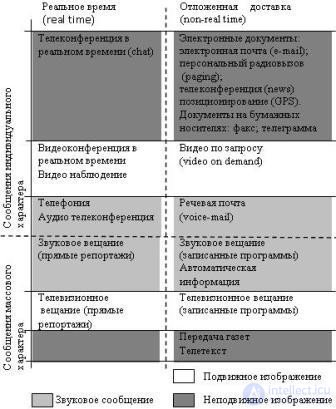Lecture
The current stage of development of science and technology is characterized by the rapid development of information technologies, in which information transfer is given a prominent place. Information means a set of information about any processes, events, facts or objects. A person receives information through the senses (vision, hearing, etc.), and the physiological capabilities of a person do not allow for the transfer of large amounts of information over considerable distances.
Technical means ensuring the transmission and reception of information are united by the concept of communication (from the Latin. Communication - communication, telecommunications - means for organizing communication at a distance). In accordance with the nature of the technical means used, communication is divided into postal and electric (telecommunications).
In communication theory, a set of information intended for transmission and presented in a certain form is called a message. So, the message is the text of the letter, telegram, announcement, broadcast on radio or television, etc. As a material carrier for the transmission of messages in communication technology use different signs (symbols). These can be letters, numbers and other signs of a text message, special signs on various diagrams and diagrams, for example, road signs and so on. In a telecommunication technique, each message is assigned a set of electrical signals.
A signal is a physical process that displays a message being transmitted. The correspondence of the process to the transmitted message is ensured by changing any physical quantity characterizing this process. Telegraphic signals, speech signals, video images or data for computer systems, etc. are distinguished. Thus, under the telecommunications understand the transmission of information through electrical signals.
Currently, the telecommunications industry is developing rapidly. With the modernization of technology improves the quality of traditional telecommunications services, new ones appear. In this connection, the well-established classifications of types of electric communication are becoming obsolete, new elements of classification appear, the boundaries between the former elements of classification change.
One of the possible classifications of types of telecommunications may be related to the characteristics of the transmitted messages and is shown in Figure 3.1.

Fig. 3.1 Characteristics of the transmitted messages
By the nature of the impact of transmitted messages on the senses, the types of electrical communication can be divided into sound or optical messages intended for transmission (that is, perceived by the organs of hearing or sight). Depending on the delay in the delivery of transmitted messages, the types of electrical communication are classified: for real-time operation and delivering a delayed message. Depending on the degree of coverage and destination of messages, all types of electrical communication can be divided into those intended for transmission: individual messages (to a specific subscriber), or mass messages (to a wide range of users).
Depending on the signal propagation medium, wired telecommunications are distinguished, in which signals are distributed via wires and electric and optical cables, and wireless telecommunications using radio signals. Some of the main types of telecommunications are: telephone, telegraph, facsimile, data transmission, radio communication, broadcasting and television.
Telecommunication systems can be classified according to other criteria. At the same time, in the modern era there is a tendency to unite the types of telecommunications into a single integrated system. The basis of the merger is the conversion of signals of any kind into digital form with the subsequent transfer of universal digital signals over communication systems.
A good example of the universal use of digital signals for transmitting messages of any nature are computer technologies that combine the simultaneous transmission of both test documents and visual images and voice messages.
Comments
To leave a comment
Devices for the reception and processing of radio signals, Transmission, reception and processing of signals
Terms: Devices for the reception and processing of radio signals, Transmission, reception and processing of signals